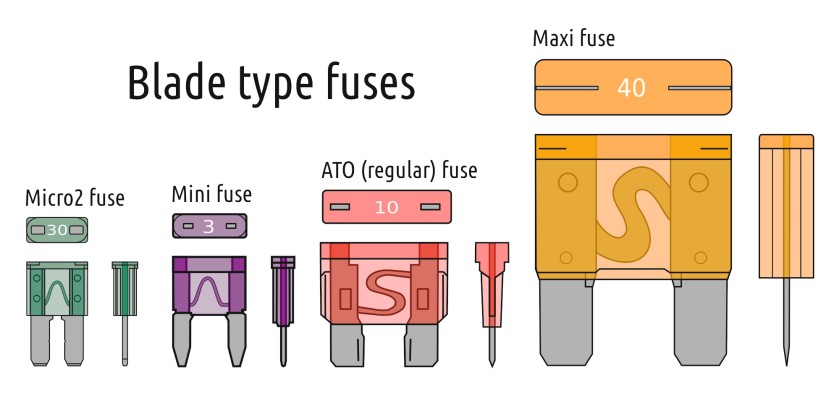Common Automotive Headlight Fuses
Their are a bunch of different style fuses (even old school glass style). I prefer to use some of the more modern
styles. Generally I like the Maxi-Fuse size for higher current applications. They are a good choice for high power
halogen replacement bulbs. A second choice would the the common ATO blade fuses. Get a good fuse holder
with heavy gauge wire like this one I have picked up online. (Ok let me get a plug in here for Amazon - Maxi-
Common Maxi-Fuse Color Amp Ratings
Yellow - 20 Amp
Green - 30 Amp
Orange - 40 Amp
Red - 50 Amp
Blue - 60 Amp
Brown - 70 Amp
Clear - 80 Amp
Purple - 100 Amp
Suggested Fuse Current Ratings
Find the total current draw for either the high or low beams (generally only one is on at a time), remember that
you have 2 lights on at any one time. This will be the minimum fuse you will need, use that number and round
up to the nearest fuse available. For typical H4 halogen 100w bulbs a 20amp (yellow). The math is pretty simple
for this -
The assumptions :
Car Battery Voltage is approx. 12 Volts (not exactly but a safe number)
Each Bulb is 100W and I have 2
So how much Current is being Drawn by all 2 bulbs at 12 Volts? That's Easy, each bulb draws 8.34 Amps at 12 Volts, and I have 2
bulbs each running at 12 Volts, so that's right at 16.7Amps. Wait, how is the magic accomplished. By this simple formula -
I = P / V
Where :
I = Current in Amps
P = Power in Watts
V = Force in Volts
So each Bulb's current is calculated as follows -
Current in Amps = 100 Watts / 12 Volts
8.33 = 100/12
Now that I have 2 bulbs that's about 16.7 Amps total and that will tell me that I am going to need at least plan for a 20 amp circuit.
For more information on how to calculate all this look at the Ohms Law Calculator (it has a similar example)
Wire Capacity
While talking about fuses it's also important to ensure you use a thick enough wire for your high power
connection to the relays and bulbs. Relays take very little current, but the bulbs can use a bunch. Use the Wire
Size Calculator to get you a rough size. For the relay control 18 Gauge wire is fine, they draw only a little
current, but for the main power and headlights they need to be much thicker. For the main feed I would try to
use 10 or 12 Gauge from the battery to fuse to relays, then from each relay which should be close to the
headlights nothing smaller then 14 gauge for the shortest of runs, better would be 12 gauge. Why the extra thick
wires? Voltage drop. The thicker the wire the less drop and that's what we are after.




